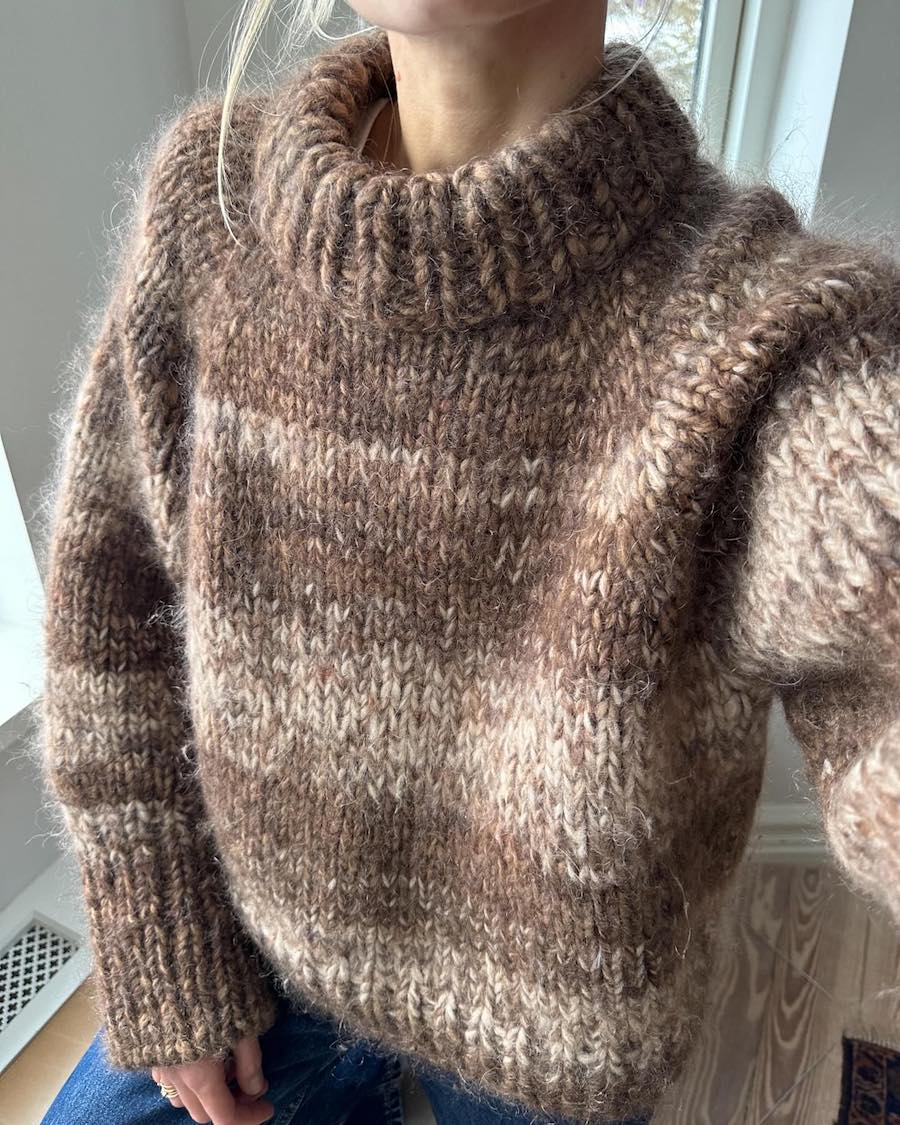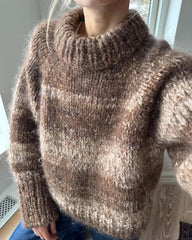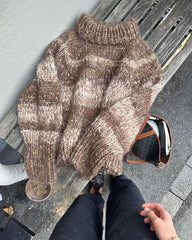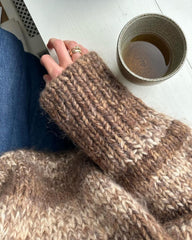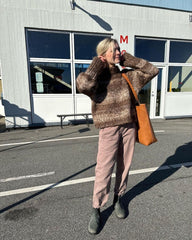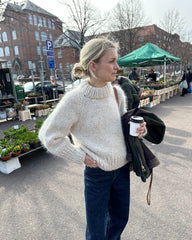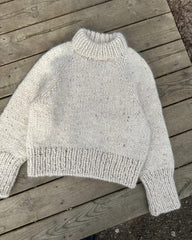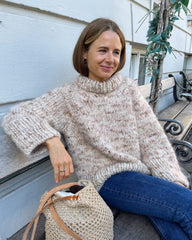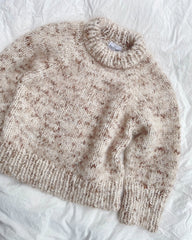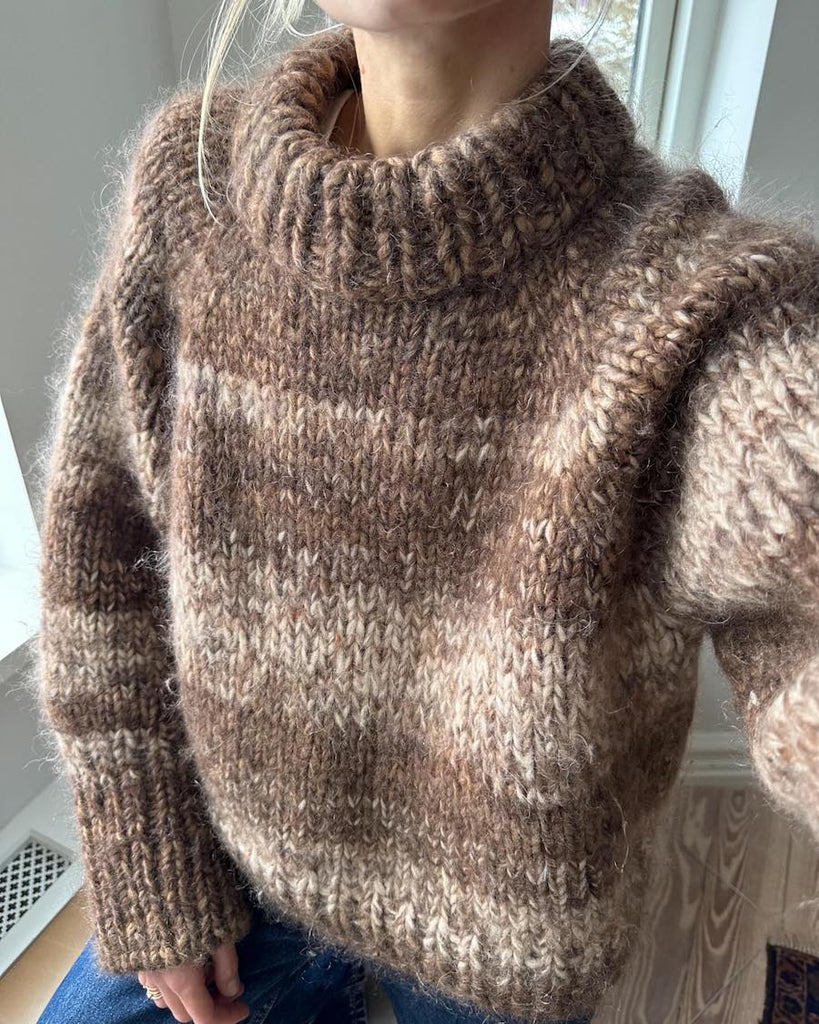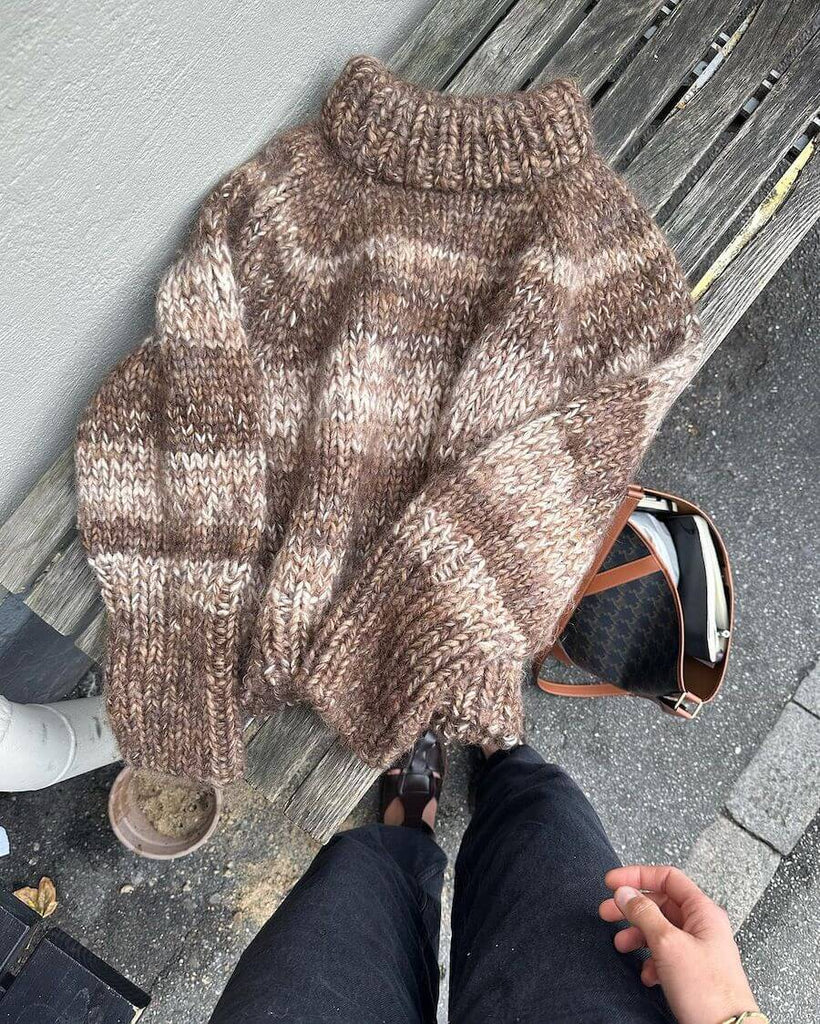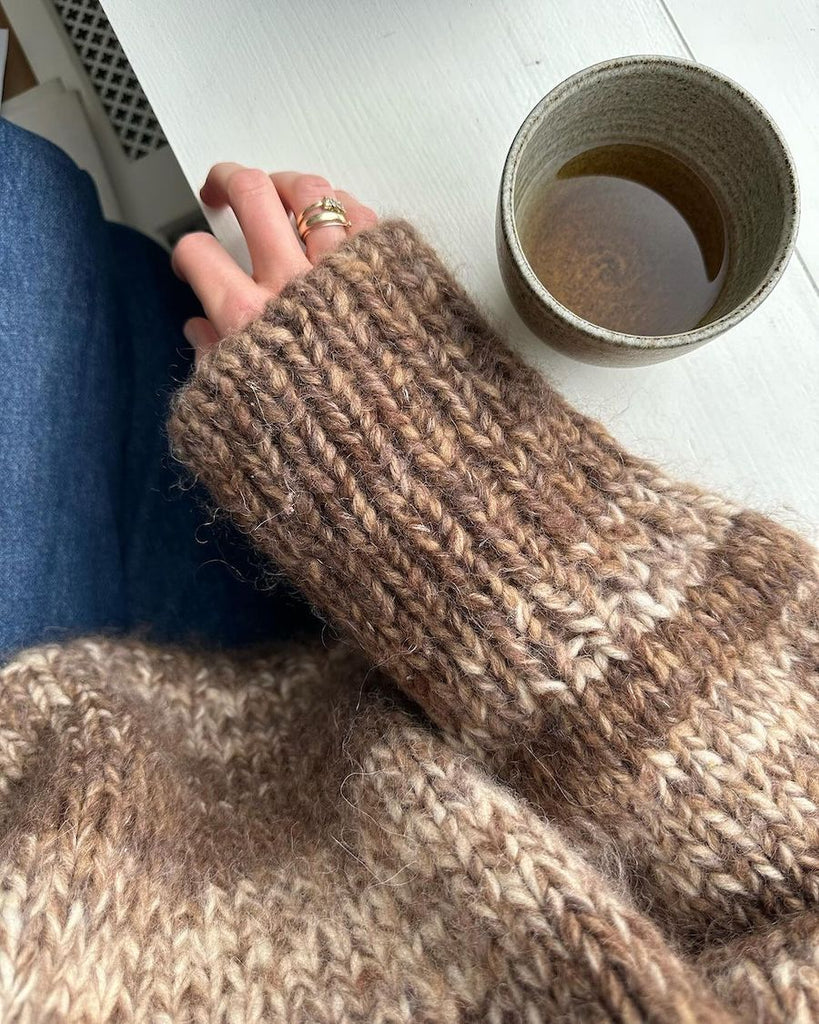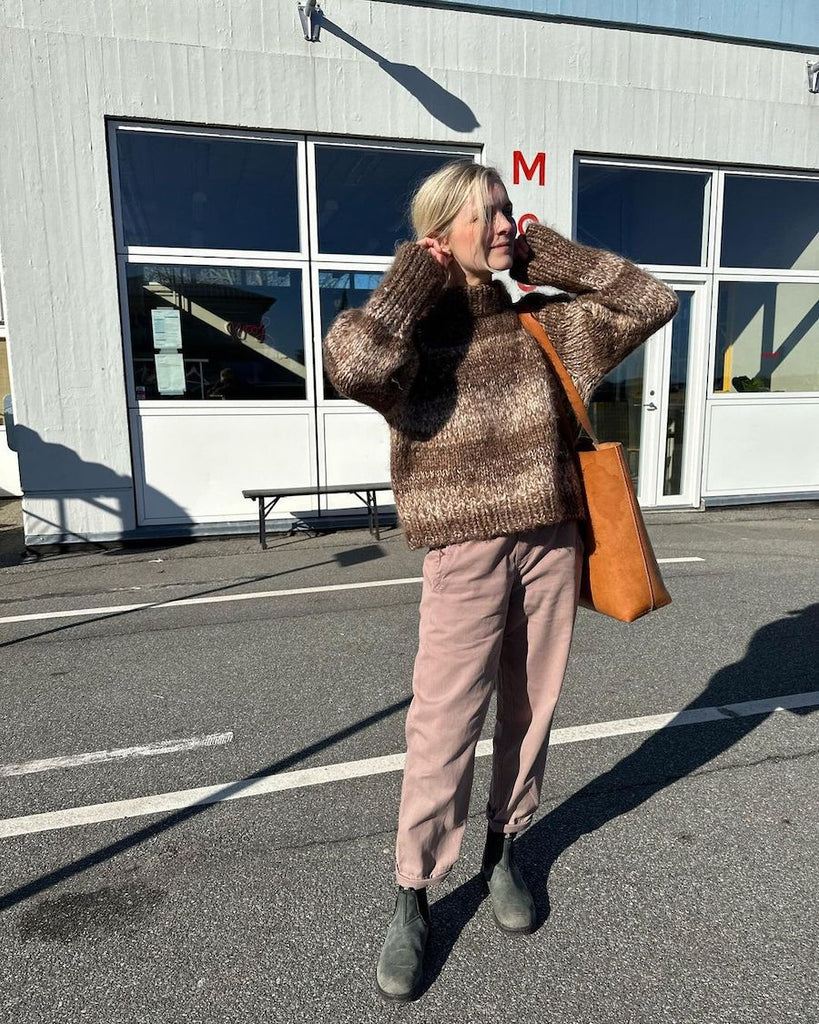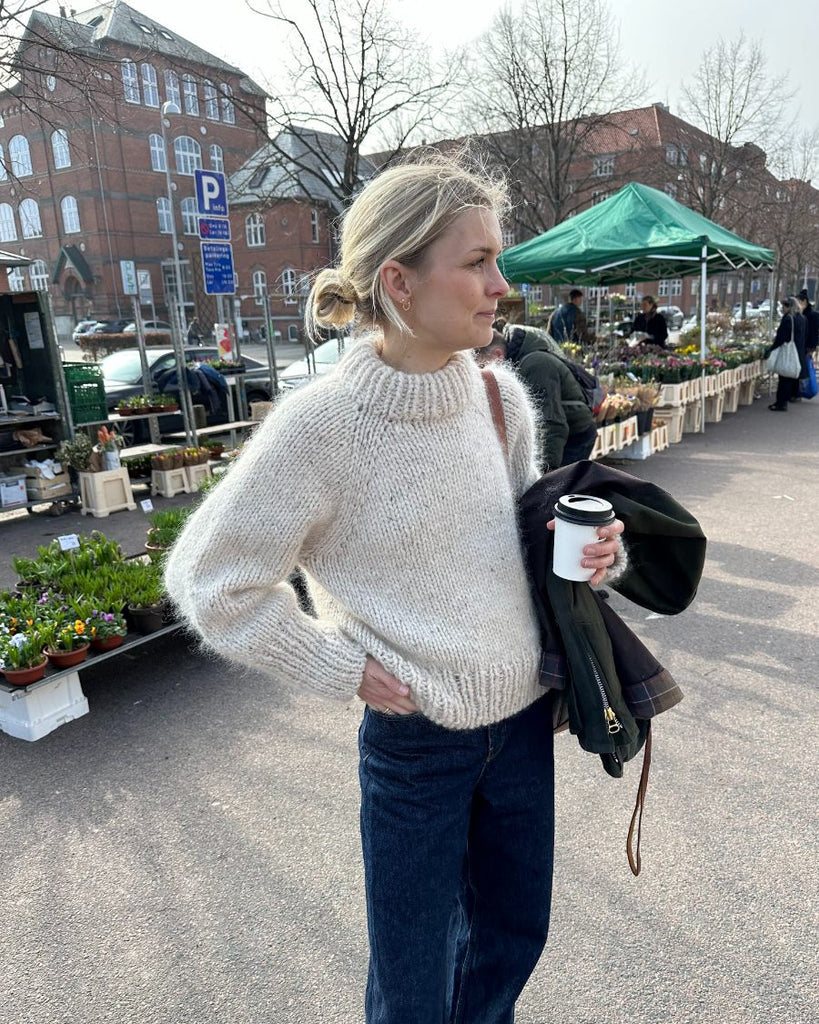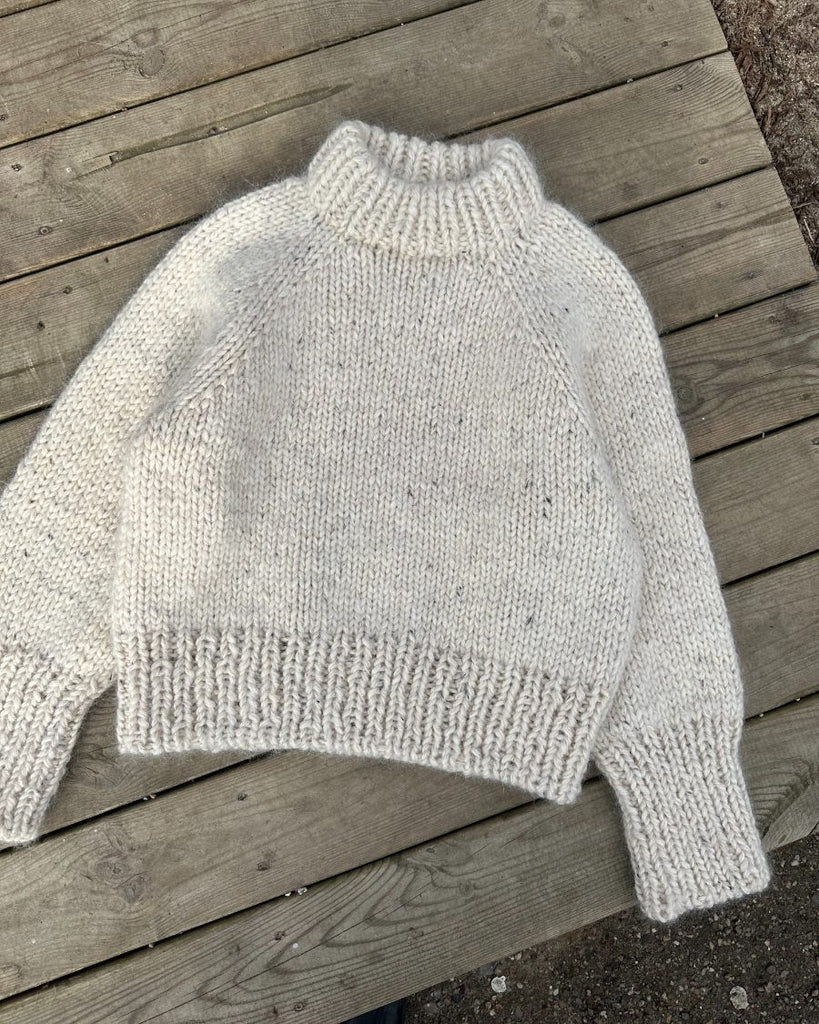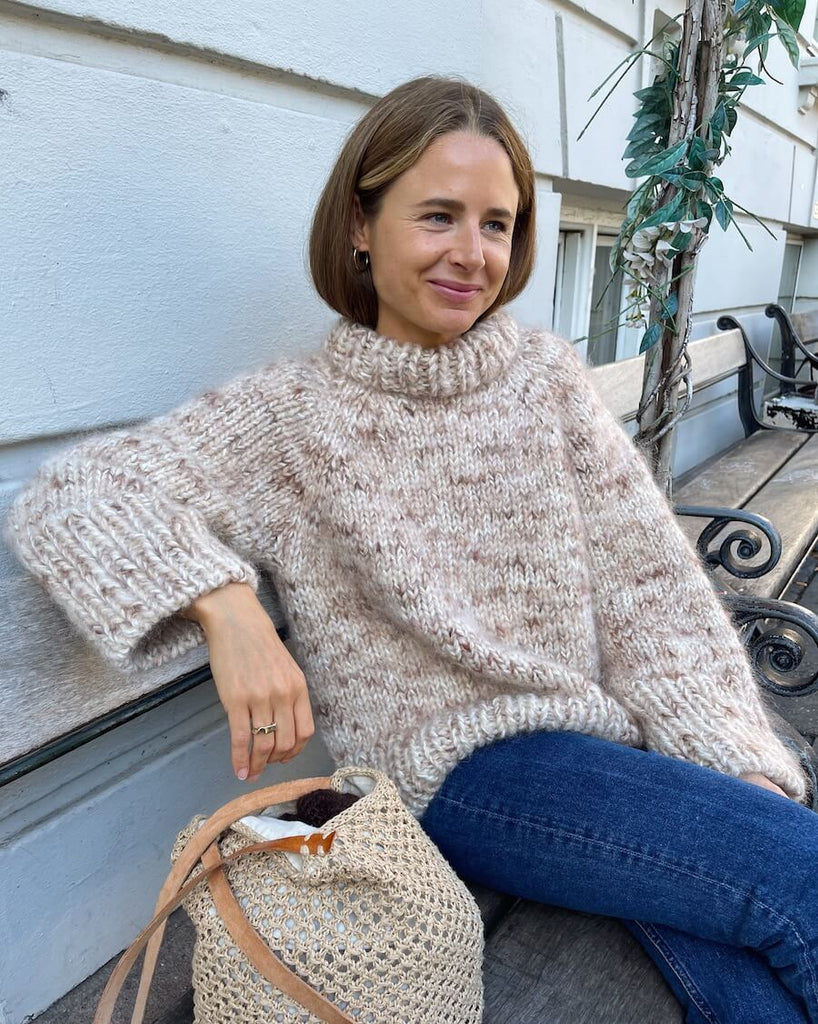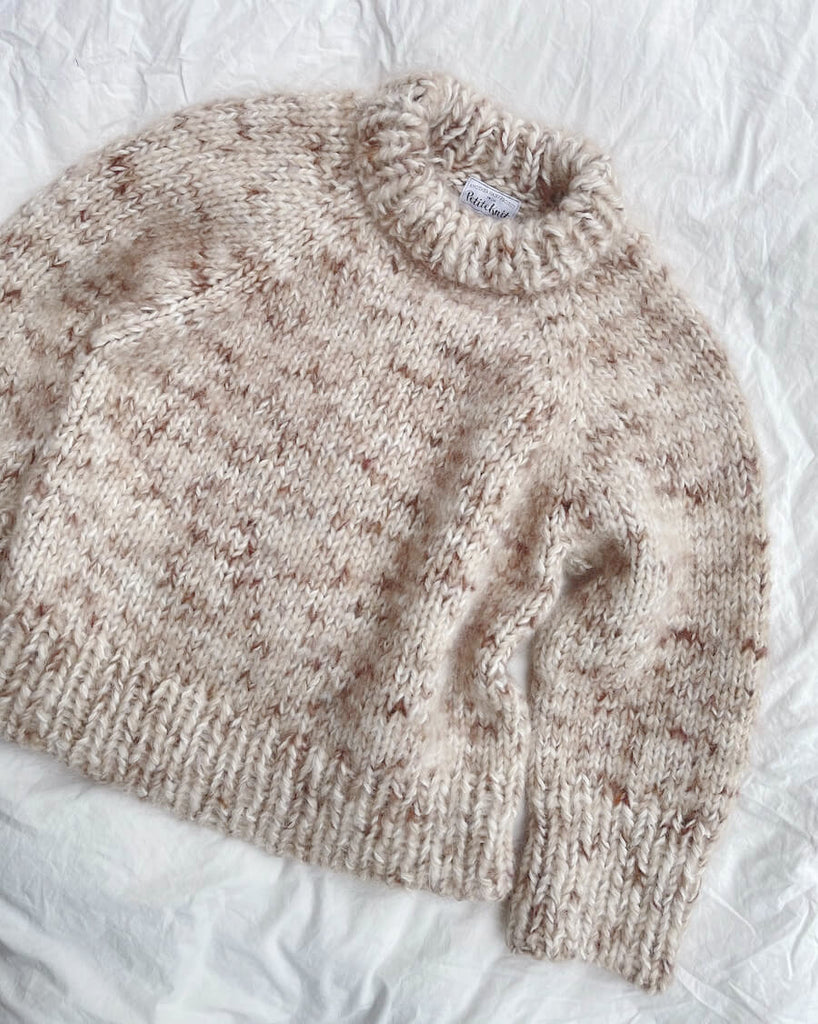Konto
Marble Sweater strikkes oppefra og ned med raglanudtagninger på bærestykket. Halskanten strikkes ned, og der strikkes vendepinde i nakken for at lave halsudskæring.
Størrelsesguide
Marble Sweater bør have et bevægelsesrum (positive ease) på ca. 20 cm i forhold til dit brystmål. Størrelserne XS (S) M (L) XL (2XL) 3XL (4XL) 5XL svarer til et brystmål målt på egen krop på 80-85 (85-90) 90-95 (95-100) 100-110 (110-120) 120-130 (130-140) 140-150 cm. Målene på den færdige sweater er angivet på forsiden af opskriften (bemærk, at disse mål kun gælder, hvis strikkefastheden overholdes). Mål dig selv, inden du går i gang med at strikke, for at vurdere hvilken størrelse, der vil passe dig bedst. Hvis du fx måler 90 cm rundt om brystet (eller det bredeste sted på din krop), bør du strikke en str. S. En sweater i str. S har overvidden 109 cm og vil i nævnte eksempel give et bevægelsesrum (positive ease) på 19 cm.
Størrelser: XS (S) M (L) XL (2XL) 3XL (4XL) 5XL
Sweaterens overvidde: 107 (109) 113 (118) 129 (138) 149 (158) 167 cm
Længde: 57 (58) 63 (65) 67 (70) 73 (75) 78 cm (midt bag uden ombukket halskant)
Strikkefasthed: 9 masker x 14 pinde i glatstrik på pind 10 mm = 10 x 10 cm
Vejledende pinde: Rundpind 10 mm (40 og 80 og/eller 100 cm), strømpepinde 10 mm
Materialer: Forslag 1: 300 (300) 300 (300-400) 400 (400) 500 (500) 600 g Fatty Mohair fra Yarnie (100 g = 200 m) strikkes sammen med 400 (400) 400 (400-500) 500 (500-600) 600 (700) 800 g Håndspundet Alpaka fra Frisenvang (100 g = 110-140 m) strikkes sammen med 250 (250) 250 (250-300) 300 (350) 400 (400) 450-500 g Eco Soft fra Isager (50 g = 125 m)
Forslag 2: 300 (300) 300 (300-400) 400 (400) 500 (500) 600 g Fat Mohair fra Sysleriget (100 g = 200 m) strikkes sammen med 600 (600) 600-700 (700) 700-800 (800) 900 (1000) 1100 g Naturuld fra Hjertegarn (100 g = 100 m)
Forslag 3: 200 (250) 250 (250) 300 (300) 350 (350) 400 g KOS fra Sandnes Garn (50 g = 150 m) sammen med 300 (300-350) 350 (400) 400 (450) 500 (550) 600 g Alpakka Ull fra Sandnes Garn (50 g = 100 m) sammen med 350 (350-400) 400 (400) 450 (500) 550 (600) 650 g Peer Gynt fra Sandnes Garn (50 g = 91 m) sammen med 200 (250) 250 (250-300) 300 (350) 350-400 (400) 450 g Ballerina Chunky Mohair fra Sandnes Garn (50 g = 135 m)
Sværhedsgrad: ★ ★ ★ (3 ud af 5)
Se klassifikationen af sværhedsgrad her.
Opskriften sendes som PDF-fil til din mail.
Den brune Marble Sweater er strikket i Fat Mohair fra Sysleriget i farven Gateau marcel sammen med Kos fra Sandnes Garn i farverne Brunt sukker [2543] og Lys marcipan [2310] og Eco Soft fra Isager i farverne 0 og 8S og Peruvian Highland Wool fra Filcolana i farverne Marzipan [977] og Camel [203]. Vær opmærksom på at denne version er strikket i rester, og at opskriften dermed hverken indeholder garnmængder eller en beskrivelse af farveskiftene.
Den hvide Marble Sweater er strikket i Kos fra Sandnes Garn i farven Lys Marsipan [2310] sammen med Alpakka Ull fra Sandnes Garn i farven Almond [2511] sammen med Peer Gynt fra Sandnes Garn i farven Almond Tweed [2512] sammen med Ballerina Chunky Mohair fra Sandnes Garn i farven Hvit [1012].
Den hvide og brune Marble Sweater er strikket i Fatty Mohair fra Yarnie i farve 19 sammen med Håndspundet Alpakka fra Frisenvang i farven naturfarvet off-white og Eco Soft fra Isager i farve 0S.
Andre garnforslag:
I stedet for Eco Soft fra Isager kan bruges 250 (250) 250-300 (300) 350 (350) 400 (450) 500 g Double Soft Merino fra Knitting for Olive (50 g = 125 m) eller 300 (300) 300 (350) 350 (400) 450 (450-500) 550 g Snefnug fra CaMaRose (50 g = 110 m) eller 200 (200) 250 (250) 250-300 (300) 350 (350) 400 g Kos fra Sandnes Garn (50 g = 150 m)
I stedet for Håndspundet Alpaka fra Frisenvang kan bruges 300 (300) 350 (350) 350-400 (400) 450 (500) 500 g Alpakka Ull fra Sandnes Garn (50 g = 100 m)
300 (300) 300 (300-400) 400 (400) 500 (500) 600 g Fed Mohair fra Siestoe Fibres (100 g = 200 m) sammen med 600 (600) 600 (700) 700 (900) 900 (1000) 1200 g Chunky Baby fra Siestoe Fibres (100 g = 100 m) og 200 (200) 200 (200) 200 (300) 300 (300) 400 g Børstet Alpakka fra Siestoe Fibres (100 g = 400 m)
Strik ombukket halskant:
Udt-h på retsiden:
Udt-v på retsiden:
Udt-h på vrangsiden:
Udt-v på vrangsiden:
German Short Rows:
Sæt ærmer til hvile:
Undgå hul ved opstart på ærme:
Italiensk aflukning:
2 ret sammen:
2 drejet ret sammen:
Marble Sweater strikkes oppefra og ned med raglanudtagninger på bærestykket. Halskanten strikkes ned, og der strikkes vendepinde i nakken for at lave halsudskæring.
Størrelsesguide
Marble Sweater bør have et bevægelsesrum (positive ease) på ca. 20 cm i forhold til dit brystmål. Størrelserne XS (S) M (L) XL (2XL) 3XL (4XL) 5XL svarer til et brystmål målt på egen krop på 80-85 (85-90) 90-95 (95-100) 100-110 (110-120) 120-130 (130-140) 140-150 cm. Målene på den færdige sweater er angivet på forsiden af opskriften (bemærk, at disse mål kun gælder, hvis strikkefastheden overholdes). Mål dig selv, inden du går i gang med at strikke, for at vurdere hvilken størrelse, der vil passe dig bedst. Hvis du fx måler 90 cm rundt om brystet (eller det bredeste sted på din krop), bør du strikke en str. S. En sweater i str. S har overvidden 109 cm og vil i nævnte eksempel give et bevægelsesrum (positive ease) på 19 cm.
Størrelser: XS (S) M (L) XL (2XL) 3XL (4XL) 5XL
Sweaterens overvidde: 107 (109) 113 (118) 129 (138) 149 (158) 167 cm
Længde: 57 (58) 63 (65) 67 (70) 73 (75) 78 cm (midt bag uden ombukket halskant)
Strikkefasthed: 9 masker x 14 pinde i glatstrik på pind 10 mm = 10 x 10 cm
Vejledende pinde: Rundpind 10 mm (40 og 80 og/eller 100 cm), strømpepinde 10 mm
Materialer: Forslag 1: 300 (300) 300 (300-400) 400 (400) 500 (500) 600 g Fatty Mohair fra Yarnie (100 g = 200 m) strikkes sammen med 400 (400) 400 (400-500) 500 (500-600) 600 (700) 800 g Håndspundet Alpaka fra Frisenvang (100 g = 110-140 m) strikkes sammen med 250 (250) 250 (250-300) 300 (350) 400 (400) 450-500 g Eco Soft fra Isager (50 g = 125 m)
Forslag 2: 300 (300) 300 (300-400) 400 (400) 500 (500) 600 g Fat Mohair fra Sysleriget (100 g = 200 m) strikkes sammen med 600 (600) 600-700 (700) 700-800 (800) 900 (1000) 1100 g Naturuld fra Hjertegarn (100 g = 100 m)
Forslag 3: 200 (250) 250 (250) 300 (300) 350 (350) 400 g KOS fra Sandnes Garn (50 g = 150 m) sammen med 300 (300-350) 350 (400) 400 (450) 500 (550) 600 g Alpakka Ull fra Sandnes Garn (50 g = 100 m) sammen med 350 (350-400) 400 (400) 450 (500) 550 (600) 650 g Peer Gynt fra Sandnes Garn (50 g = 91 m) sammen med 200 (250) 250 (250-300) 300 (350) 350-400 (400) 450 g Ballerina Chunky Mohair fra Sandnes Garn (50 g = 135 m)
Sværhedsgrad: ★ ★ ★ (3 ud af 5)
Se klassifikationen af sværhedsgrad her.
Opskriften sendes som PDF-fil til din mail.
Den brune Marble Sweater er strikket i Fat Mohair fra Sysleriget i farven Gateau marcel sammen med Kos fra Sandnes Garn i farverne Brunt sukker [2543] og Lys marcipan [2310] og Eco Soft fra Isager i farverne 0 og 8S og Peruvian Highland Wool fra Filcolana i farverne Marzipan [977] og Camel [203]. Vær opmærksom på at denne version er strikket i rester, og at opskriften dermed hverken indeholder garnmængder eller en beskrivelse af farveskiftene.
Den hvide Marble Sweater er strikket i Kos fra Sandnes Garn i farven Lys Marsipan [2310] sammen med Alpakka Ull fra Sandnes Garn i farven Almond [2511] sammen med Peer Gynt fra Sandnes Garn i farven Almond Tweed [2512] sammen med Ballerina Chunky Mohair fra Sandnes Garn i farven Hvit [1012].
Den hvide og brune Marble Sweater er strikket i Fatty Mohair fra Yarnie i farve 19 sammen med Håndspundet Alpakka fra Frisenvang i farven naturfarvet off-white og Eco Soft fra Isager i farve 0S.
Andre garnforslag:
I stedet for Eco Soft fra Isager kan bruges 250 (250) 250-300 (300) 350 (350) 400 (450) 500 g Double Soft Merino fra Knitting for Olive (50 g = 125 m) eller 300 (300) 300 (350) 350 (400) 450 (450-500) 550 g Snefnug fra CaMaRose (50 g = 110 m) eller 200 (200) 250 (250) 250-300 (300) 350 (350) 400 g Kos fra Sandnes Garn (50 g = 150 m)
I stedet for Håndspundet Alpaka fra Frisenvang kan bruges 300 (300) 350 (350) 350-400 (400) 450 (500) 500 g Alpakka Ull fra Sandnes Garn (50 g = 100 m)
300 (300) 300 (300-400) 400 (400) 500 (500) 600 g Fed Mohair fra Siestoe Fibres (100 g = 200 m) sammen med 600 (600) 600 (700) 700 (900) 900 (1000) 1200 g Chunky Baby fra Siestoe Fibres (100 g = 100 m) og 200 (200) 200 (200) 200 (300) 300 (300) 400 g Børstet Alpakka fra Siestoe Fibres (100 g = 400 m)
Strik ombukket halskant:
Udt-h på retsiden:
Udt-v på retsiden:
Udt-h på vrangsiden:
Udt-v på vrangsiden:
German Short Rows:
Sæt ærmer til hvile:
Undgå hul ved opstart på ærme:
Italiensk aflukning:
2 ret sammen:
2 drejet ret sammen:

